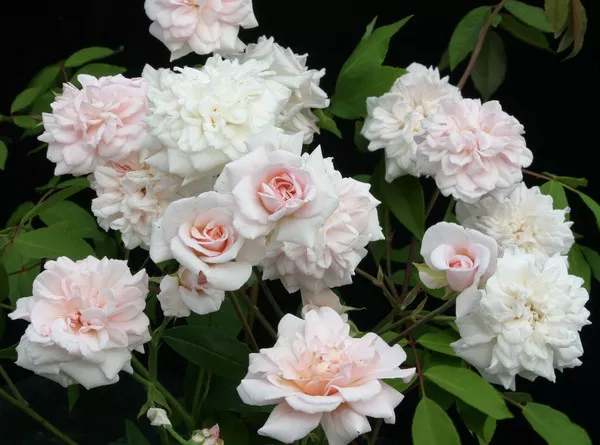Powdery mildew, caused by the fungal pathogen Sphaerotheca pannosa var. rosae, is one of the most common and troublesome diseases affecting roses (Rosa spp.). This insidious fungal infection not only mars the beauty of these beloved ornamental plants but also weakens them, making them more susceptible to other diseases and environmental stressors. Fortunately, with diligent attention and the application of appropriate treatment strategies, powdery mildew can be effectively managed, allowing roses to thrive and flourish in the garden.
Understanding Powdery Mildew
Before delving into treatment methods, it’s crucial to understand the nature of powdery mildew and how it affects roses. Powdery mildew appears as a white to gray powdery growth on the surfaces of leaves, stems, and buds of infected plants. It thrives in warm, dry conditions with high humidity, making it a common problem in many regions during the spring and summer months.
This fungal disease not only detracts from the aesthetic appeal of roses but also interferes with their photosynthetic processes, reducing the plant’s ability to produce energy. Severe infections can lead to stunted growth, distorted foliage, and premature leaf drop, weakening the overall health of the plant.
Cultural Practices for Powdery Mildew Prevention
Prevention is often the best defense against powdery mildew. By implementing sound cultural practices, gardeners can create an environment that is less conducive to the development and spread of this fungal disease. Here are some key practices to consider:
1. Plant Selection: Choose rose varieties known for their resistance to powdery mildew. While no rose is completely immune, some cultivars exhibit greater tolerance to the disease.
2. Spacing and Air Circulation: Proper spacing between rose plants promotes good air circulation, which helps reduce humidity levels and inhibits the growth of powdery mildew. Avoid overcrowding plants and prune them regularly to improve airflow within the canopy.
3. Watering Practices: Water roses at the base of the plant early in the day to allow foliage to dry quickly. Avoid overhead watering, which can promote the spread of fungal spores.
4. Mulching: Apply a layer of organic mulch around the base of rose plants to help conserve soil moisture and suppress weed growth. However, be mindful not to create conditions where moisture is trapped against the plant, as this can encourage powdery mildew development.
5. Sanitation: Remove and dispose of any fallen leaves or infected plant material promptly to prevent the spread of powdery mildew spores. Prune out and destroy severely infected foliage to reduce disease pressure.
Chemical Control Options
In cases where cultural practices alone are insufficient to control powdery mildew, chemical interventions may be necessary. Several fungicides are available for the management of powdery mildew on roses, but it’s essential to use them judiciously and according to label instructions to minimize environmental impact and maximize effectiveness. Here are some commonly used fungicides for powdery mildew control:
1. Sulfur-based Fungicides: Sulfur has long been recognized for its effectiveness against powdery mildew and other fungal diseases. Sulfur-based fungicides work by inhibiting fungal growth and can be applied as dusts or sprays. However, sulfur can be phytotoxic to certain rose varieties, particularly when temperatures are high, so it’s important to test for sensitivity before widespread application.
2. Horticultural Oils: Horticultural oils, such as neem oil or mineral oil, suffocate powdery mildew spores and disrupt fungal cell membranes, effectively controlling the disease. These oils are generally safe to use and have minimal impact on beneficial insects, but they should be applied when temperatures are mild to avoid causing leaf burn.
3. Fungicidal Soaps: Fungicidal soaps are another option for managing powdery mildew on roses. These potassium salts of fatty acids work by disrupting the cell membranes of fungal spores, ultimately leading to their demise. Fungicidal soaps are relatively safe for use on roses and can be applied as needed throughout the growing season.
4. Synthetic Fungicides: In severe cases where other treatment options have failed, synthetic fungicides containing active ingredients such as myclobutanil, triforine, or propiconazole may be necessary. These chemical fungicides provide systemic protection against powdery mildew and should be applied according to label instructions, taking care to minimize environmental impact.
Integrated Pest Management (IPM) Approaches
In addition to chemical control options, integrated pest management (IPM) strategies can help manage powdery mildew on roses while minimizing reliance on synthetic chemicals. IPM involves a holistic approach to pest and disease management that combines cultural, biological, and chemical control methods. Here are some IPM techniques for combating powdery mildew:
1. Biological Controls: Encourage natural predators and parasites of powdery mildew, such as ladybugs, lacewings, and predatory mites, to establish populations in the garden. These beneficial insects feed on powdery mildew spores and help keep populations in check.
2. Resistant Varieties: Select rose varieties known for their resistance to powdery mildew, reducing the need for chemical interventions.
3. Monitoring and Early Detection: Regularly inspect rose plants for signs of powdery mildew and other diseases, intervening early to prevent widespread infestations.
4. Cultural Practices: Implement cultural practices that promote plant health and vigor, making roses less susceptible to powdery mildew and other stressors.
5. Rotating Fungicides: Rotate between different classes of fungicides to reduce the risk of resistance development in powdery mildew populations.
Conclusion
Powdery mildew poses a significant challenge to rose enthusiasts, but with proper care and attention, it can be effectively managed. By implementing cultural practices that promote plant health, employing chemical control options judiciously, and embracing integrated pest management strategies, gardeners can keep powdery mildew at bay and enjoy healthy, vibrant roses throughout the growing season. Remember to stay vigilant, monitor your plants regularly, and intervene promptly at the first sign of trouble to keep powdery mildew under control. With dedication and perseverance, you can protect your roses and preserve their beauty for years to come.


